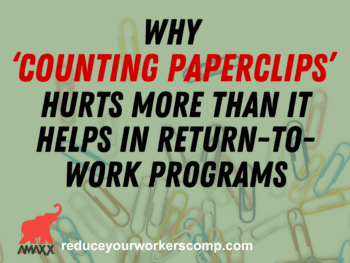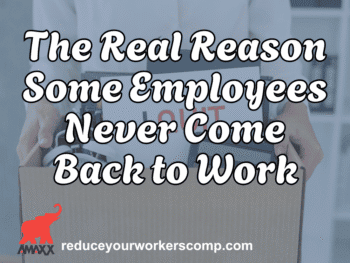
Companies that take that concept to heart see significant savings on their own bottom lines. It just takes a firm commitment from management and a concerted, continuous effort to implement a successful workers’ comp pre-loss program.
In addition to reduced accident frequency and substantially lower workers’ compensation costs, companies that embrace a pre-loss program also benefit from better product and service quality, enhanced productivity, lower indirect-injury costs, and an overall improved image in the community.
Management’s Role
An effective pre-loss program starts at the top, with the recognition that management is ultimately responsible for preventing workplace accidents. Additionally, there must be a person or people designated to ensure accountability for safety decisions that have been made.
Managers and supervisors need to lead by example and reinforce safety policies that are implemented. That includes heading or attending safety committee meetings, participating in the investigation of any and all lost-time injuries that do occur, and integrating safety and health into overall strategic business plans.
Top tier leaders should establish safety performance improvement objectives and follow-up on the progress made for approved safety improvement plans. Finally, they should track and include adherence to safety objectives in employee performance reviews.
The Plan
Developing and implementing an effective safety policy takes time and effort. It begins with small steps.
- Set goals — Realistic improvement goals should first be established. Employers can look at their data or work with their insurer/third-party administrator for any trends in terms of accidents and injuries. For example, are there specific facilities and/or job duties that are more susceptible to workers’ compensation claims? Once trends have been identified, employers can determine ways to reduce those claims and set goals; however, the goals must be realistic, communicated to all employees and tracked.
- Training — All new employees should be required to undergo safety orientation. However, safety training and education should also be provided on a regular, ongoing basis to all employees. In large corporations, that duty falls to safety management staff. But even small companies can ensure ongoing training by managers and/or supervisors who are trained. The training should be formal and documented. Working safely should be considered a condition of employment
- Enforcement — Supervisors must enforce safety rules and regulations consistently. In fact, executing the company safety policy needs to be an integral part of the supervisor’s job description.
- Timely Investigations — All accidents should be investigated within 24 hours. The sooner the better, since the incident is still fresh in the minds of any witnesses, as well as the injured employee.
- Facility Hazard Inspections — Part of a good pre-loss program includes regular inspections of company facilities to identify and correct any hazards that may exist. Workers who might be affected by identified hazards should receive special training.
- Employee Engagement — Workers need to be encouraged to actively participate in the safety program. They should be included in safety committee meetings, facility hazard inspection teams, and training of new employees in their departments. Employees should be rewarded for reporting unsafe working conditions and behaviors.
- Companywide — The safety plan requires the cooperation of all departments, especially HR, production, engineering, and maintenance.
- Transparency — Safety as a topic should be openly discussed informally as well as in safety committee meetings. Workers should feel comfortable talking about potential hazards and possible solutions with their supervisors and one another.
Safety Culture
The success of a pre-loss program depends largely on the overall safety culture at the organization. All personnel should be engaged in the idea that safety and health is simply the way business is done at the company.
Rather than a reactive strategy where there is action taken once an accident occurs, the organization needs to have a proactive strategy to identify and address potential safety problems. Again, that starts at the top.
Managers and supervisors must treat workers fairly and consistently. They must believe and convey that they and the company are truly concerned about the well-being of their employees. They also need to foster an atmosphere of respect — with their workers and among employees.
Post Injury
While the idea of a pre-loss program is to prevent workplace accidents and injuries, there should, nevertheless, be a specific process in place for any claims that do occur. The post-injury claims management process should include the following elements:
- Formal RTW — A documented return-to-work process that is laid out and communicated to all employees should be established. Included should be restricted-duty job descriptions.
- Physician Involvement — Treating physicians and other medical providers should be familiar with and engaged in the RTW process. They should have access to the restricted-duty job descriptions. Physicians should also be invited to tour the facility/facilities to better understand the job tasks.
- Solid Relationships with Claims Specialists — employers should establish good working relationships with claims managers and administrators.
Conclusion
Spending resources at the front end of the workers’ compensation process is too often ignored by companies. But employers that fully embrace the idea of safety at every level of the organization report significant cost savings, increased productivity and better morale among their employees.
Author Michael Stack, Principal, Amaxx LLC. He is an expert in workers compensation cost containment systems and helps employers reduce their work comp costs by 20% to 50%. He works as a consultant to large and mid-market clients, is co-author of Your Ultimate Guide To Mastering Workers Comp Costs, a comprehensive step-by-step manual of cost containment strategies based on hands-on field experience, and is founder & lead trainer of Amaxx Workers’ Comp Training Center. .
Contact: mstack@reduceyourworkerscomp.com.
Workers’ Comp Roundup Blog: https://blog.reduceyourworkerscomp.com/
©2017 Amaxx LLC. All rights reserved under International Copyright Law.
Do not use this information without independent verification. All state laws vary. You should consult with your insurance broker, attorney, or qualified professional.
















